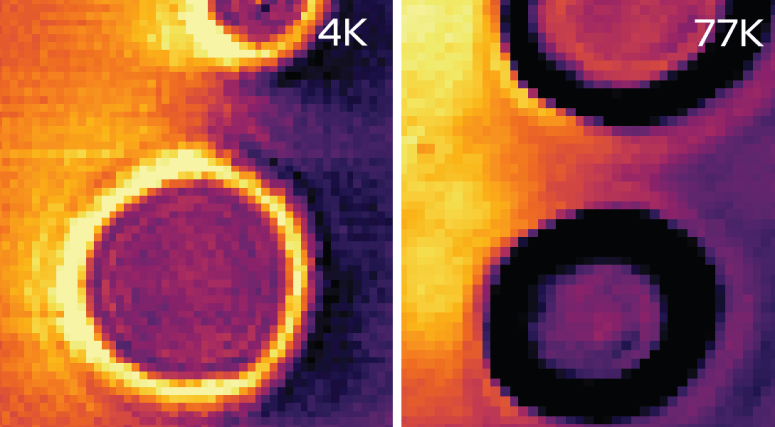The fluid-like movement of electrons in graphene was directly observed by physicists at the University of Wisconsin-Madison for the first time at a nanometer resolution. The findings have the potential for creating new, low-resistance materials where electrical transmission is more effective, and they will be published in the journal Science.
 A heatmap of electron location in graphene shows that at the lower temperature (left panel), the electrons are more likely to bump into impurities (circles), with relatively fewer making it through the channel between impurities. At higher temperatures (right panel), electron flow shifts to being fluid-like. Fewer are stuck at the impurities and more flow through the channels. Image Credit: University of Wisconsin–Madison
A heatmap of electron location in graphene shows that at the lower temperature (left panel), the electrons are more likely to bump into impurities (circles), with relatively fewer making it through the channel between impurities. At higher temperatures (right panel), electron flow shifts to being fluid-like. Fewer are stuck at the impurities and more flow through the channels. Image Credit: University of Wisconsin–Madison
Since it is an exceptionally pure electrical conductor and has a very low resistance, graphene—an atom-thick sheet of carbon organized in a honeycomb pattern—is the perfect material to examine electron movement.
All conductive materials contain impurities and imperfections that block electron flow, which causes resistance. Historically, people have taken a low-resolution approach to identifying where resistance comes from.
Zach Krebs, Study Co-Lead Author and Physics Graduate Student, University of Wisconsin-Madison
Krebs added, “In this study, we image how charge flows around an impurity and actually see how that impurity blocks current and causes resistance, which is something that hasn’t been done before to distinguish gas-like and fluid-like electron flow.”
The graphene obstacles were purposefully added by the researchers, placed at specific intervals, and then the sheet was subjected to an electrical current. They created a 2D map of the electron flow pattern by measuring the voltage at every point on the graphene with nanometer resolution using a method called scanning tunneling potential (STP).
Regardless of the distance between obstacles, the channel’s voltage drop was substantially smaller at a higher temperature (77 K) than at a lower temperature (4 K), suggesting reduced resistance and more electrons passing through.
At absolute zero, graphene electrons behave like a gas, diffusing in all directions and more likely to collide with objects than to interact with one another. Electron flow is relatively inefficient and resistance is increased.
The fluid-like nature of electrons means they interact with each other more than with barriers at higher temperatures, such as 77 K, or –196 ℃, where they flow like water between two rocks in the middle of a stream. It appears as though the electrons are navigating around the rocks by exchanging information about the obstruction.
Krebs added, “We did a quantitative analysis [of the voltage map] and found that at the higher temperature, the resistance is much lower in the channel. The electrons were flowing more freely and fluid-like. Graphene is so clean that we’re forcing the electrons to interact with each other before they interact with anything else, and that is crucial in getting them to behave like a fluid.”
Journal Reference:
Krebs, Z. J., et al. (2023) Imaging the breaking of electrostatic dams in graphene for ballistic and viscous fluids. Science. doi:10.1126/science.abm6073.
Source: http://www.wisc.edu/